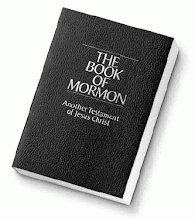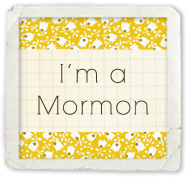As I mentioned in my last post, the church is taking steps to dispel the misconceptions about Mormonism. I’m excited that the church will be rolling out a media campaign in our area this month. I came across this article in the East Valley Tribune which discusses the campaign.
Posted: Saturday, October 1, 2011 3:00 pm | Updated: 4:07 pm, Sat Oct 1, 2011.
Mormon media campaign looks to dispel misconceptions (By Lawn Griffiths, for the Tribune East Valley Tribune)
It is getting personal in the Mormon Church.
Members of the Church of Jesus Christ of Latter-day Saints are showcasing themselves on the Internet and in TV commercials to dispel misconceptions and stereotypes about their faith and to try to show they’re a diverse group of people who are “as regular as anyone else,” in the words of one Mormon, Don Harkey of Ahwatukee Foothills.
The Valley is one of a dozen major markets where the Mormon Church this week is launching a national media campaign called “I’m A Mormon.” The project is anchored by the website Mormon.org, an attractively designed place featuring close-up sketches of members. They include wholesome, engaging video profiles of Mormons who have overcome daunting life challenges, but came out with their faith intact or strengthened.
Rather than hard-sell evangelism, the videos focus on members’ personal lives, before they end their remarks with the simple words, “and I am a Mormon.”
Area TV stations will begin running advertisements highlighting Mormons, while there will also be a dozen billboards in the Valley as well as ads in buses. The effort will continue for six months. Local church leaders were unable to say the cost of the advertising campaign.
Data shows there are 387,956 Mormons in Arizona, of which 190,000 reside in the Valley. Of the 801 wards, or congregations in the state, 490 are in the metro area.
“Research shows that despite our being the fourth largest Christian faith in the United States, many are not familiar with our faith, or they have received misinformation about it,” said Cindy Packard, Arizona spokeswoman for the church. “Rather than simply explaining our beliefs and practices, the redesigned website highlights people sharing their own stories in their own words.”
The key, she said, is an emphasis “not so much on what we believe but what we do because of what we believe.”
The “I’m a Mormon” campaign comes out of church research that found half of Americans had never met a Mormon, but when they had done so, “misconceptions about the church fell away,” according to campaign materials. After the Mormon.org site was redesigned in June 2010, church members were invited to write their profiles and share their testimonies worldwide with a few computer clicks.
Curtis Keller of Gilbert wrote his profile immediately and posted it, but says he should get back to updating it. “It is a great way to show people what we believe,” he said. “I think there is a common misconception about Mormons that they don’t believe in Jesus Christ” or that they, instead, worship their prophet and founder, Joseph Smith.
“I answered that: ‘Of course not. We revere Joseph Smith as a prophet, but we worship Jesus Christ as our savior, knowing that if we believe in Jesus Christ and accept him, we can be forgiven of our sins and receive redemption.’”
Keller, who is the bishop of the Fairview Ward in the Higley Stake, said members repeatedly are asked about polygamy, which the church officially ended in 1890.
“It’s out there that Mormons are ‘weird’ or ‘odd’ people,”Keller said. He noted that LDS members have long regarded themselves as “a peculiar people” because of a special covenant they believe they have with God. “Yes, it goes back a long ways that we will be a ‘peculiar people,’ and I think we are a ‘peculiar people’ in today’s standards in that we have pretty traditional moral standards. The world doesn’t have the same moral standards that we are used to.”
The campaign, he said, “helps people understand that Mormons are like your neighbors next door: They have tough times in their lives, and they have happy times” and hold down many kinds of jobs.
For Kara Kelly, the campaign will “clarify information” about her church. She said “people don’t know about us” and, too often, focus on things they hear “that have been taken out of context,”including the “crazier things in history” that may have been sensationalized. “But if you really know the real people, you get a better picture,” she said.
Kelly, who is a third-generation Mormon on her father’s side and at least three generations on her mother’s side, said the campaign smartly uses the latest technology to respond to misconceptions.“It is mostly taking advantage of where the world is going with technology.”
Miranda Culiver of Gilbert sees the campaign as an effective way“to illustrate that we are everyday people. We are school teachers, we are serving in our communities, we are neighbors and we are also Mormons.”
A convert to Mormonism when she was 19, Culiver, now 31, who works for the city of Mesa, teaches fourth-graders at her ward on Sunday mornings. She doesn’t regard the campaign as a defense of the church, but instead an opportunity to demonstrate one’s “faith and testimony in Jesus Christ, and anytime someone has a question or comment, it just presents us members with an opportunity to better explain who we are.”
East Valley Mormons say they believe the campaign, which had previously been test-marketed in nine cities, including Tucson, will help dispel stereotypes.
Mark Mendon, father of six, said his wife Michelle and their son Josh are the first in the family to write their profiles forMormon.org. “Josh talked about himself, what he does, why he believes and why it makes a difference in his life,” Mendon said.“… The goal is to help people recognize who we are, and that we are normal people.”
Noting that Mormons are known for their “knocking on doors to share the Gospel of Jesus Christ,” the head of the denomination’s missionary department, David F. Evans, said, “Mormon.org gives people the opportunity to knock on our door through the Internet and ask members questions about our faith.”
The church currently has 52,000 full-time missionaries worldwide.
Harkey calls the campaign “an invitation,” in a non-threatening way, for non-members to hear Mormons from across the world tell about themselves. Harvey, who completed his own Mormon mission in Tennessee in 1976, has three sons who have been sent to Australia, Argentina and Connecticut for missions.
“The whole point of those missions was to teach people about Jesus Christ and his gospel and share his message throughout the world,” Harkey said.
He emphasized that the videos and profiles that members recorded or wrote have been left in their original form, not even modified for grammar or spelling. “The videos use no make-up or art direction,” he said.
Young Mormons especially have been sharing their stories and getting questions from their non-LDS peers.
“This is not surprising given the presence this has on YouTube, Twitter and Facebook,” Harkey said. “This gives young people a tremendous opportunity to communicate our message of Christ to their peers in their own personal way.”
So far, nearly a half-million people have been visiting Mormon.org monthly. Members locally and nationally dismiss suggestions that the church campaign coincides with the current U.S. presidential campaigns of Mitt Romney and Jon Huntsman, who are Mormons and former state governors.
“I don’t see that it is any way connected to Mitt Romney,”Keller said, noting the church had begun developing the campaign more than two years ago. “The church’s stance has always been to let politics take care of themselves.”






No comments:
Post a Comment